Purple foods are very healthy and succulent.
According to data from the National Health and Nutrition Examination Study, adults who consume purple foods regularly have a reduced risk for high blood pressure and low HDL and are less likely to become overweight.
The nutrients contained in purple foods may vary depending on the fruit, vegetable, or grain, but they are all rich in a purple pigment called anthocyanins.
For this reason, most foods that are purple are associated with a wide range of benefits, including cancer prevention, improved vision, and increased longevity.
There is plenty of healthy purple food you can add to your meal plan, keep reading to learn more about them.
Purple Foods
Although there aren’t many purple things in our world, let’s take a look at some foods that are purple and their benefits:
1. Purple Basil
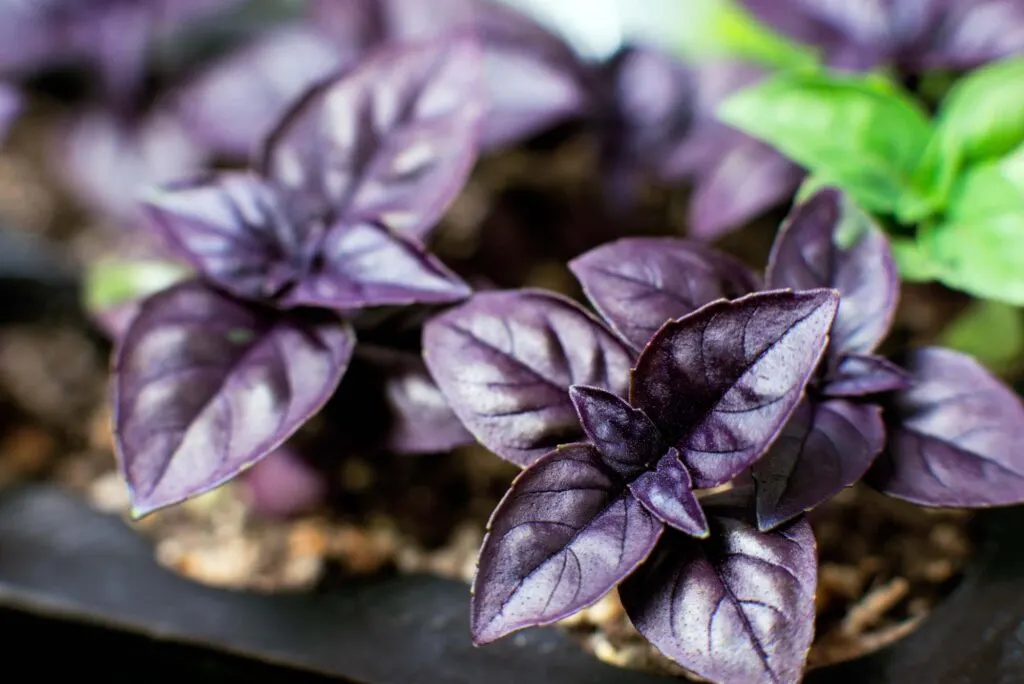
Like other green basil leaves, purple basil is common in Africa, America, and Asia.
Purple basil stands out for its colored hue and is full of nutrients, especially vitamin K, which aids bone strength and blood clothing.
When cooked, purple basil turns black, so it’s best used fresh in salads, pesto, soups, and other basil recipes.
Purple basil also contains vitamins A, C, and E and antioxidants that protect the body, boost the immune system, and combat skin ailments.
Also, studies show that purple basil is rich in phenolic compounds like arachidonic, jasmonic, and aminobutyric acid.
These nutrients boost the immune system, protect cells from oxidative cells and reduce the risk of chronic diseases like cancer, diabetes, and heart diseases.
2. Indigo Rose Tomato
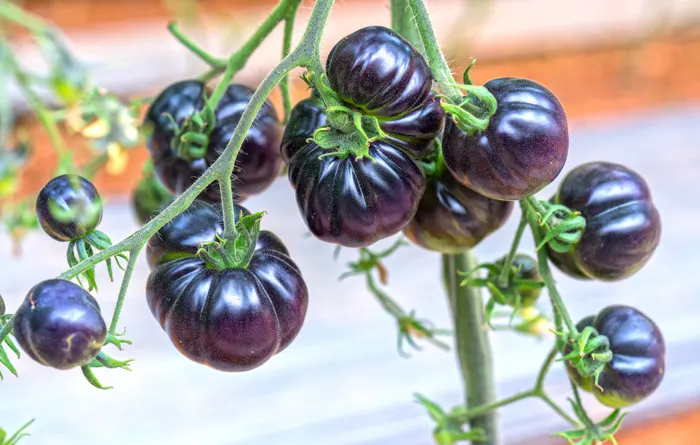
These dark purple fruits were developed with traditional breeding techniques and contain a high concentration of anthocyanins.
Their high anthocyanin content makes them a great food choice to reduce the risk of cardiovascular diseases like diabetes.
Indigo rose tomatoes are usually available from mid-august with a colorful skin and juicy inside with a mild sour taste.
In many cases, Indigo rose tomatoes are dark on the side facing the sun while the side away from the sun exhibits a soft pink, red color. However, in some cases, the tomatoes are dark all over.
3. Purple Carrot
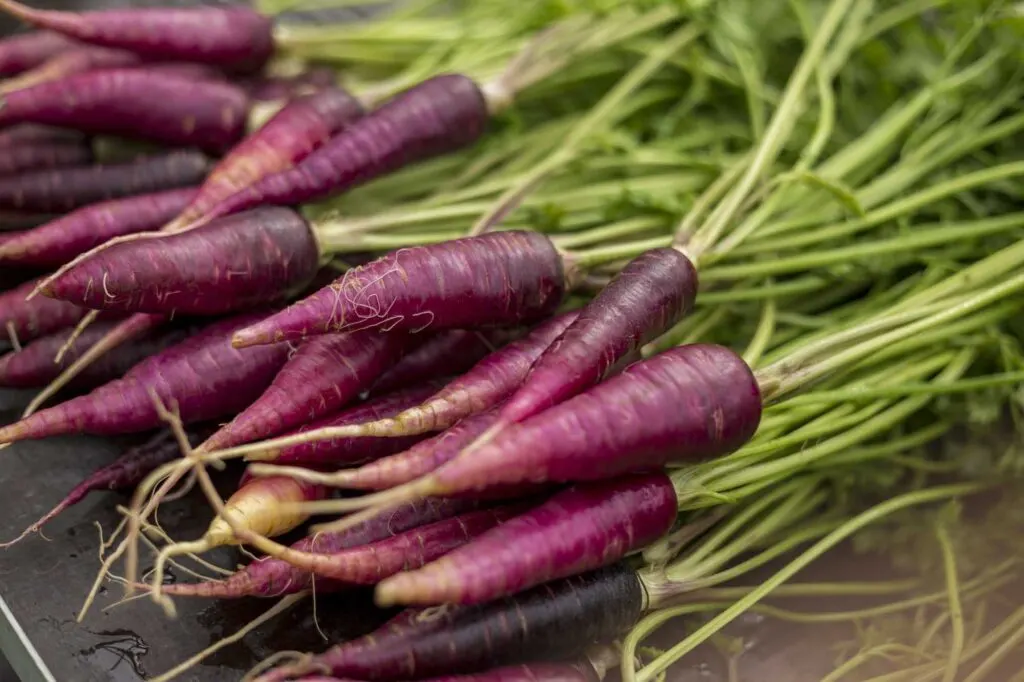
Carrots weren’t always orange; they used to be purple and yellow!
The purple varieties are now available again after scientists discovered that they contain some genes that make them more resistant to diseases and pests.
In the same vein, these purple vegetables contain a high level of anthocyanins and alpha and beta carotene, which provide many health benefits, including improved immunity and eye health.
Purple carrots have 28% more anthocyanin antioxidants than orange carrots and contain polyphenol, which reduces the risk of heart diseases, diabetes, and obesity.
Also, they are lower in sugar than orange carrots and have an earthy flavor (sometimes they exhibit a peppery flavor).
You can eat them raw to get most of the nutrients, roast them, or add them to your stir fry and other dishes.
4. European Plum
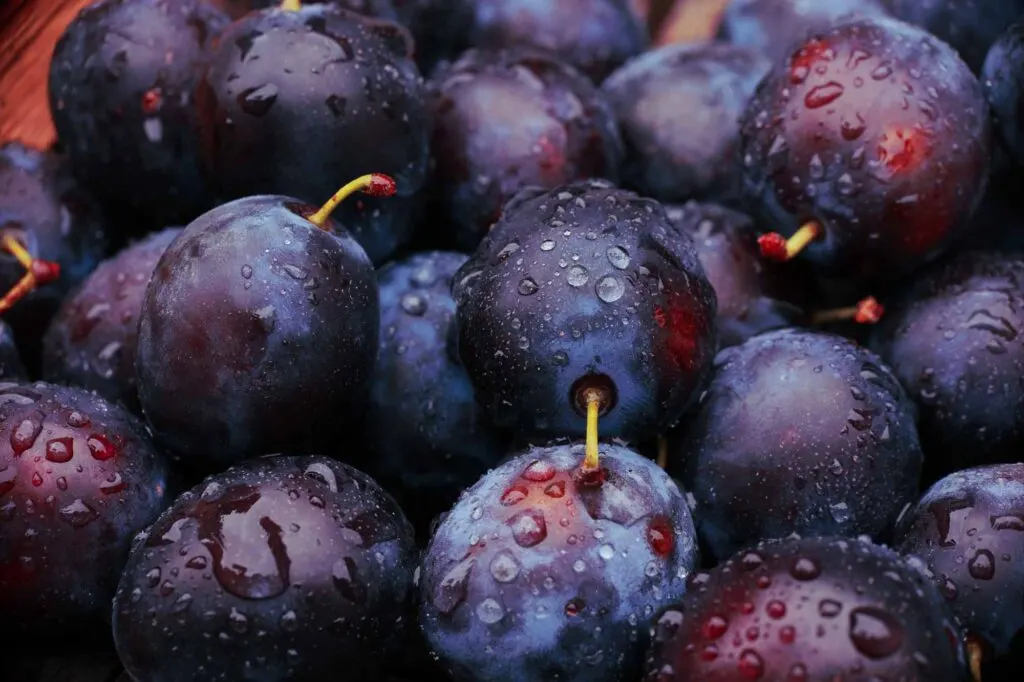
European plums usually express a shade of purple-blue skin and are often processed into jams and jellies. They are a great source of vitamin C, vitamin A, vitamin B2, and potassium.
They also contain fiber, and studies show that moderate and regular consumption of plums can reduce blood pressure and protect cells from damage.
Plums are also full of nutrients like calcium, iron, and magnesium and are usually available from May to October.
5. Red Dragon Fruit
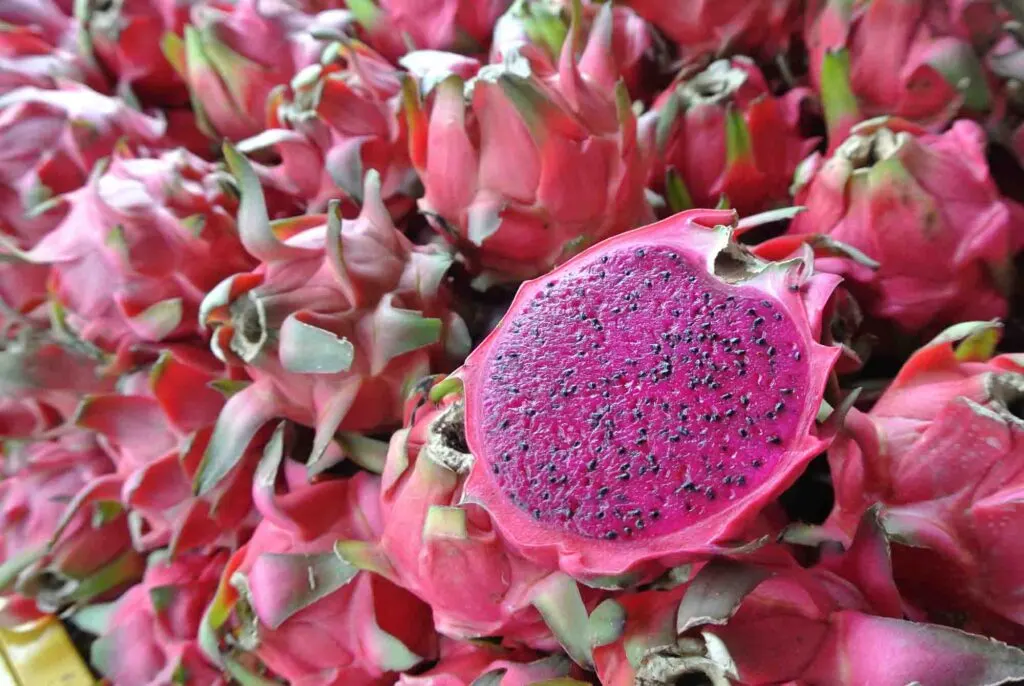
Red dragon fruit has a reddish purple flesh with tiny, black edible seeds that tastes mildly sweet.
Dragon fruits are very low in calories but are high in nutrients like vitamin C, magnesium, fiber, and antioxidant levels.
A test tube research done with extract of red dragon fruit showed that it could inhibit the growth of specific cancer cells, including breast cancer.
They make great savory and nutritional additions to fruit salads and other sweet meals.
6. Ulluco

Ulluco is an edible tuber widely grown in the Andrea region of South America and tastes like sweet corn or beets.
They are pronounced as oo-yoo-ko and are common in South American dishes. It tastes starchy like potatoes, but some have a mildly sweet taste that is hard to resist.
Ulluco has many health benefits, including aiding digestive functions, delaying cell aging, and protecting the body against rheumatism.
Purple Ulluco is also rich in vitamins which help to aid iron absorption and protect cells from damage.
Adding Ulluco to your diet will bump your fiber intake without worrying about calorie consumption because they are low on that.
7. Acai Berry
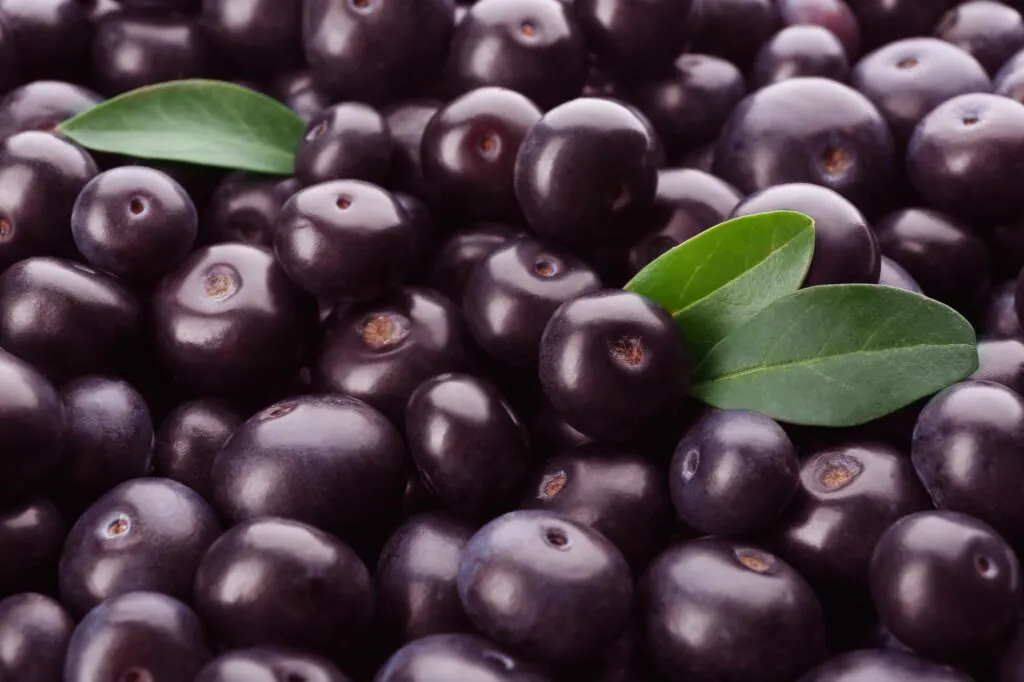
Acai berries are small, tasty purple fruits from Brazil[] containing nutrients that can help improve cognitive functions, cholesterol levels, blood sugar levels, and heart health.
These bright purple berries also contain a lot of vitamin C, fibers, and high concentrations of anthocyanins.
You can include these juicy berries into your diet by using them to make acai bowls, juices, and smoothies.
8. Star Apple
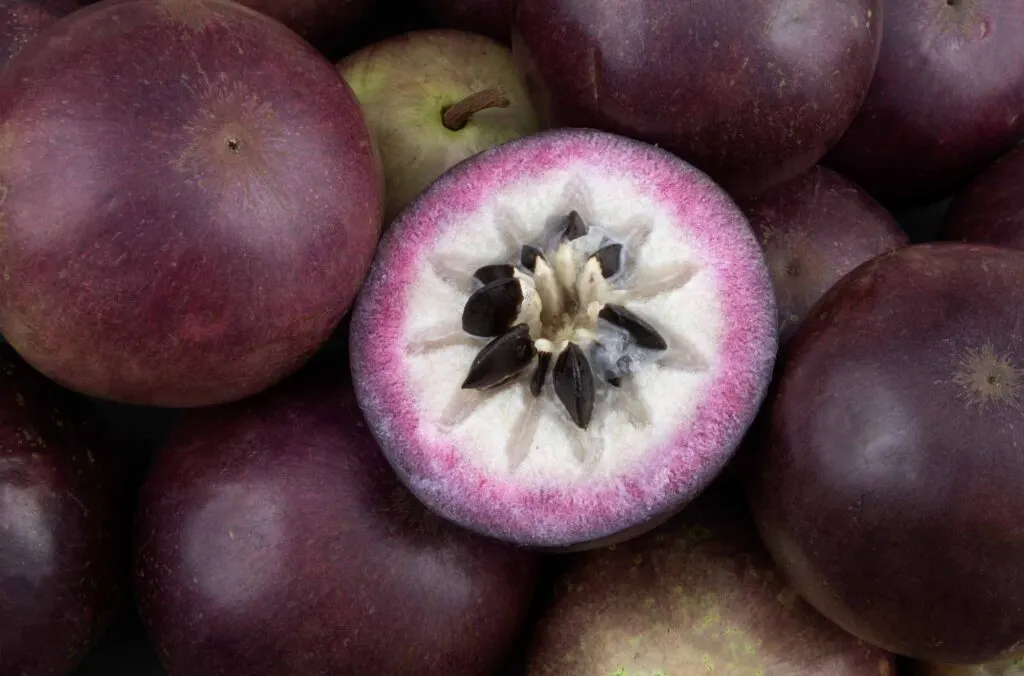
The purple star apple has a thin purple skin and juicy white flesh that looks like a star when sliced in halves.
Studies associate a regular intake of anthocyanin-rich foods like star apple with a reduced risk of cardiovascular disease, type 2 diabetes, and improved weight maintenance.
Also, some research suggests that star apple has some gastrointestinal benefits due to its abundance of antioxidants.
Historically, star apple trees’ fruits, leaves, and bark were used medicinally to treat ailments like cough and diabetes.
9. Passion Fruit
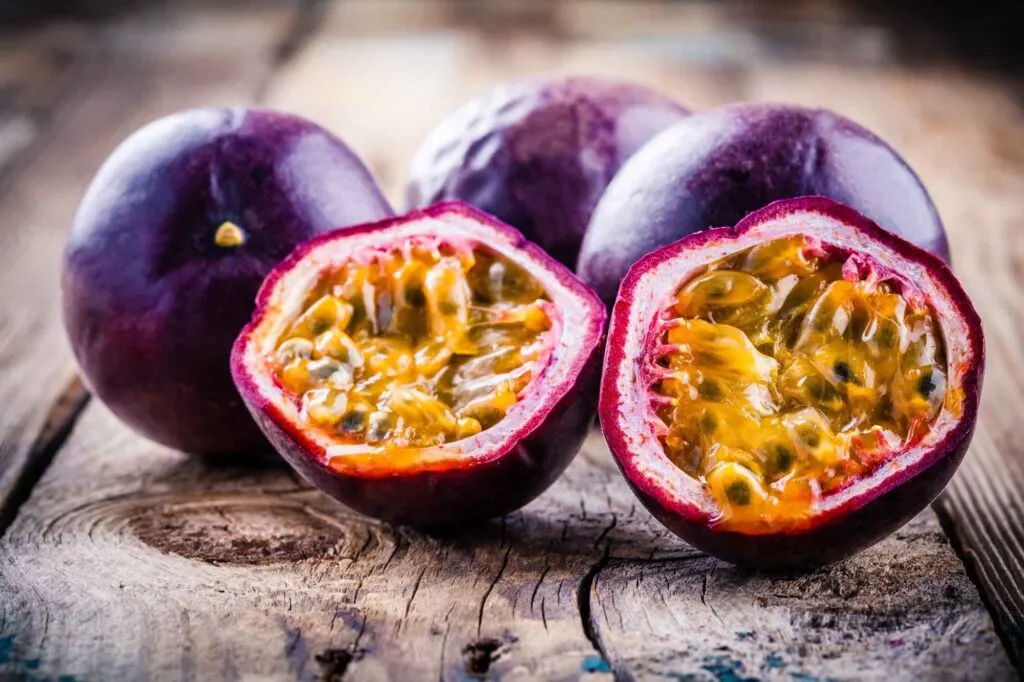
This juicy tropical fruit has sweet-tart flavors, soft flesh, and crunchy seeds that remind one of guava.
Passion fruit contains piceatannol, a polyphenol antioxidant linked to several health benefits, including improved skin health.
A study done on 32 women with dry skin showed that piceatannol increased their skin moisture after taking 5mg of the substance for eight weeks. With these benefits in mind, it’s time you start buying and eating passion fruits.
10. Blackberry
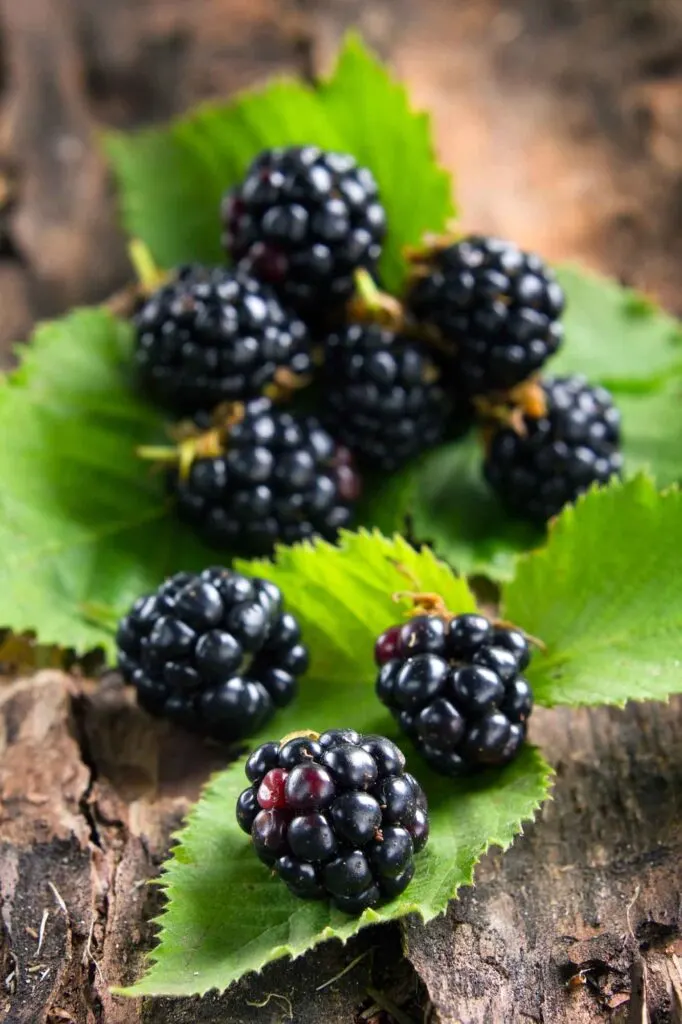
It’s impossible to make a list of foods that are purple without blackberries; they are one of the most popular purple foods out there.
Blackberries are super rich in antioxidants and are an excellent food choice to boost your mood and brain functions.
Research also suggests that eating blackberries can prevent chronic health conditions like cancer and diabetes.
Also, berries are rich in anthocyanins, and it’s encouraged to eat more of them because they help protect cells from damage and prevent chronic health conditions like diabetes.
Blackberries are also rich in other nutrients like fiber, vitamin C, K, A, potassium, and magnesium, all of which are necessary for optimal body system functioning.
11. Purple Grape
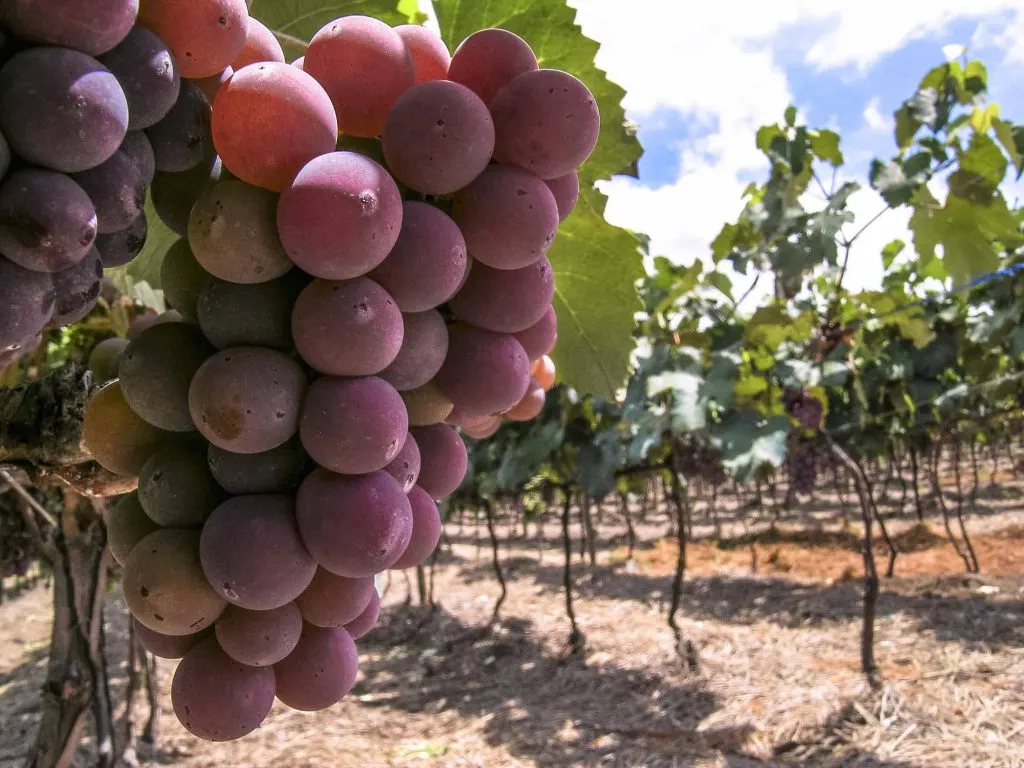
These juicy fruits are rich in antioxidants and phytonutrients that help prevent cancer cell growth and reduce cholesterol levels.
Also, the skin of purple grapes contains anthocyanins and resveratrol, a polyphenolic compound with anti-inflammatory and antioxidant properties.
This compound protects the cells from free radicals that can lead to many human diseases, including neurodegenerative diseases common in older people.
Blood flow reduction is linked to neurological disorders like strokes, Alzheimer’s, and dementia.
However, resveratrol in foods like purple grapes can increase blood flow in the brain, thus reducing the risk of these diseases.
A study by Kennedy et al. (2010) on the benefits of resveratrol showed that the compound improved cerebral blood flow in 22 healthy adults.
12. Black Rice Cooked

Black rice, also known as forbidden rice, isn’t forbidden to eat, as the name may suggest.
The rice earned the name because it was reserved for the Chinese emperor to ensure his health and longevity. For this reason, people were not allowed to eat it.
Unlike other rice varieties, black rice takes a deep purple color when cooked and is rich in nutrients like anthocyanin.
The anthocyanins contained in cooked black rice have been shown to inhibit cancer cell growth.
Just like white and brown rice, you can use black rice in a variety of recipes like soups and stir-fries.
Aside from getting a lot of beneficial health boosts by eating black rice, they taste and look great on a plate too!
13. Purple Corn
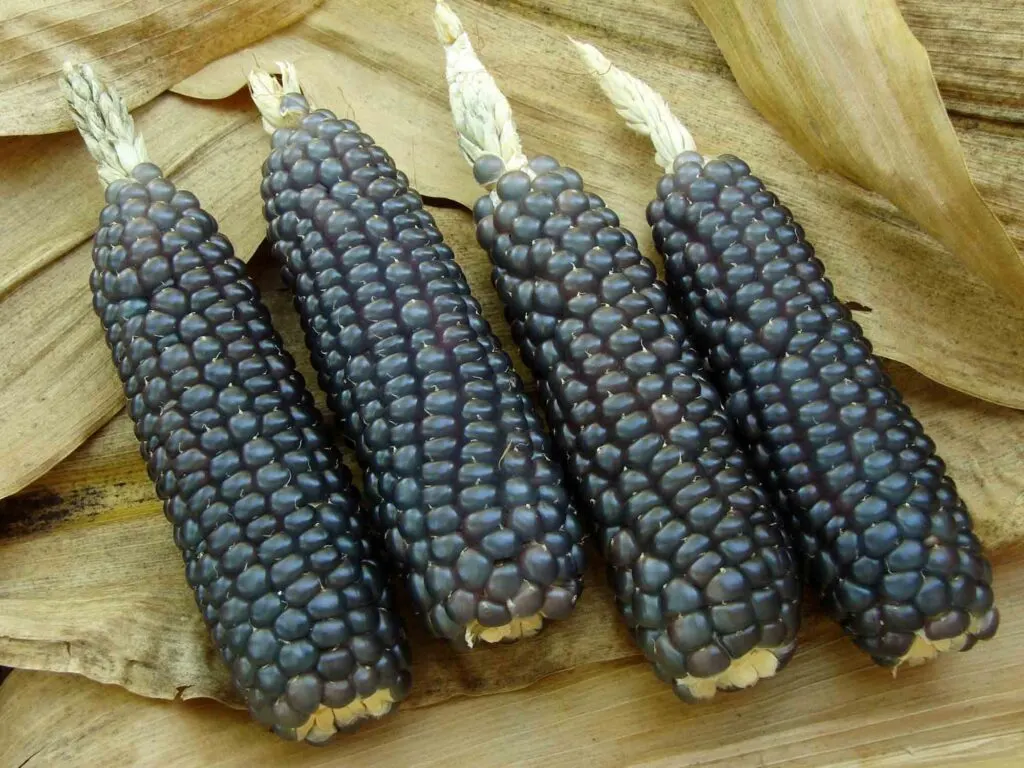
Purple corn originates from South America and has one of the most vibrant shades of purple in the plant kingdom.
Studies show that purple corn has high phenolic content and elements that can fight many human diseases.
Purple corn can reduce inflammation, boost weight loss, prevent diabetes, and reduce the risk of certain types of cancer.
These grains are common in Mexican and American Southwest cuisine and are often used to make corn chips and tortillas. Purple corns are also delicious; they have a tender crisp and a taste close to sweet corn.
14. Royal Burgundy Green Beans
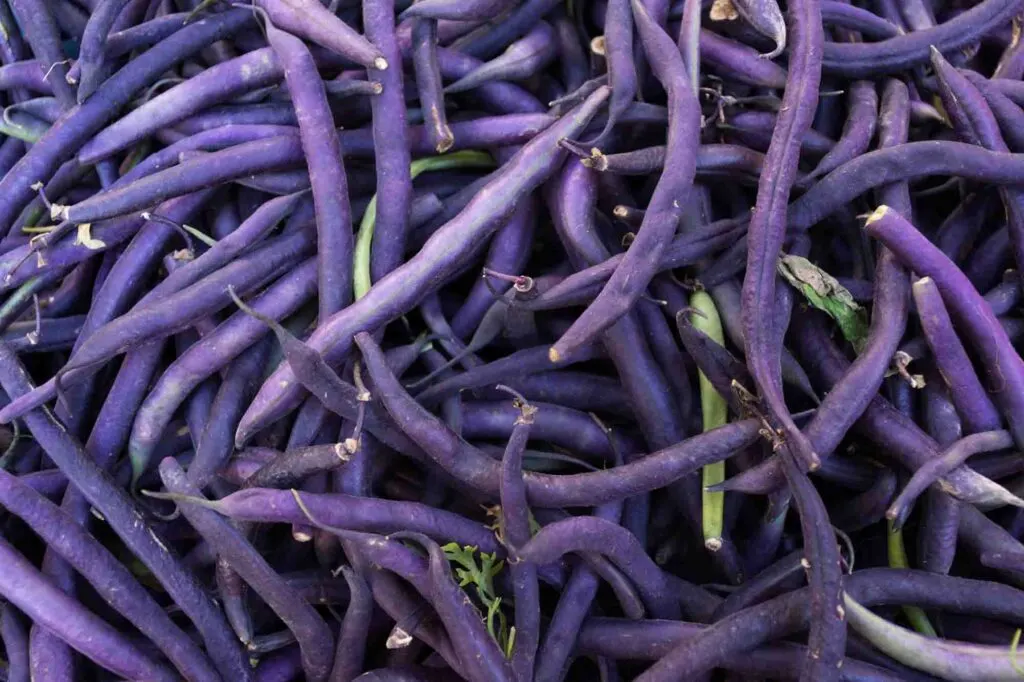
Royal burgundy green beans have a bright dark purple color that turns green when cooked.
They are rich in beneficial nutrients and are great for canning, cooking, freezing, and fresh eating.
Royal burgundy green beans are a great source of vitamins A, C, and K and also contain a high amount of chlorophyll, which can block carcinogenic effects.
Research also suggests that these beans are very beneficial for fertility and pregnancy due to the high amount of iron.
15. Purple Garlic
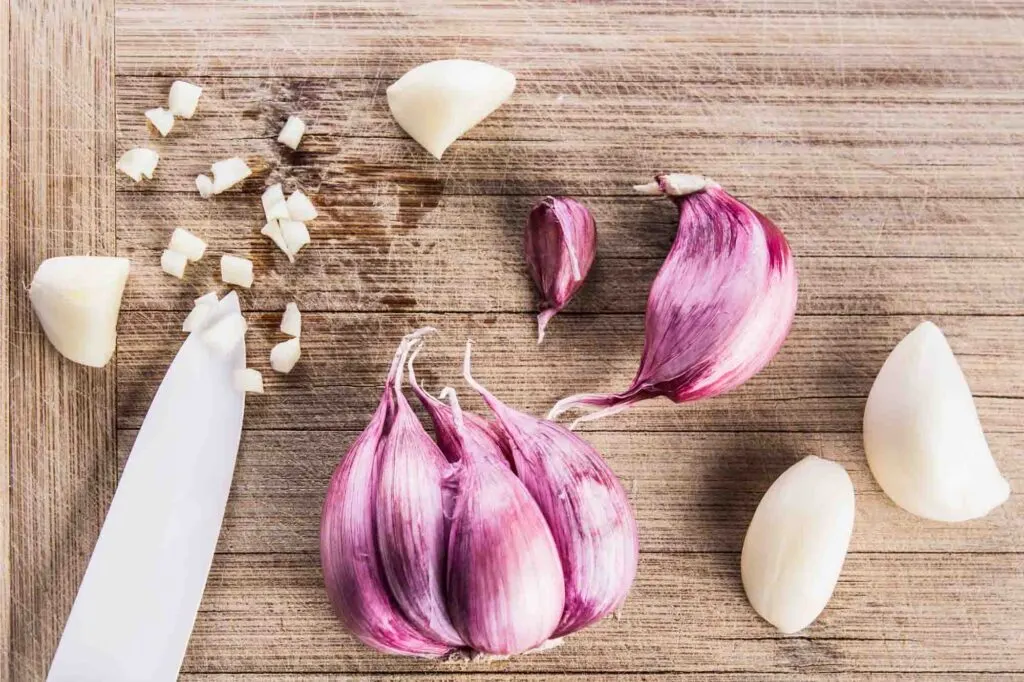
Regular garlic is already associated with plenty of benefits, and the purple variant is no exception.
Add them as a spice to your meals, use them for your garlic bread, make a roasted garlic dip or use it as you would your white garlic.
Purple garlic contains a compound called Allicin which has a lot of antioxidant and hypoglycemic properties.
This means consuming it can lower your blood sugar levels and reduce free radicals in the body.
The cloves of purple garlic are juicier and flavorful, and although they are not very common, you can find them in specialty and farmers’ markets. When you see them, buy them before someone else does.
16. Elderberry
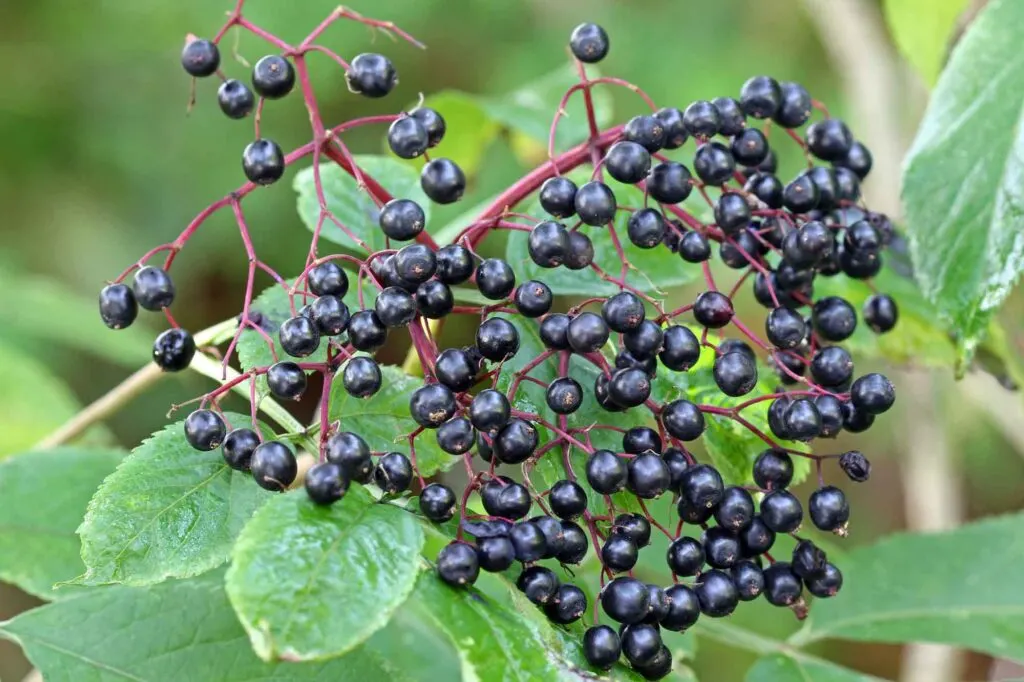
A super fruit: elderberry has immune-supporting properties and is sometimes used in natural remedies like syrups and capsules to treat colds and flu.
This purple fruit is also very rich in fiber and vitamin C, and you can add them to your meal plan by making them into jam, jellies, fruit juice, or syrups.
17. Okinawan Sweet Potato
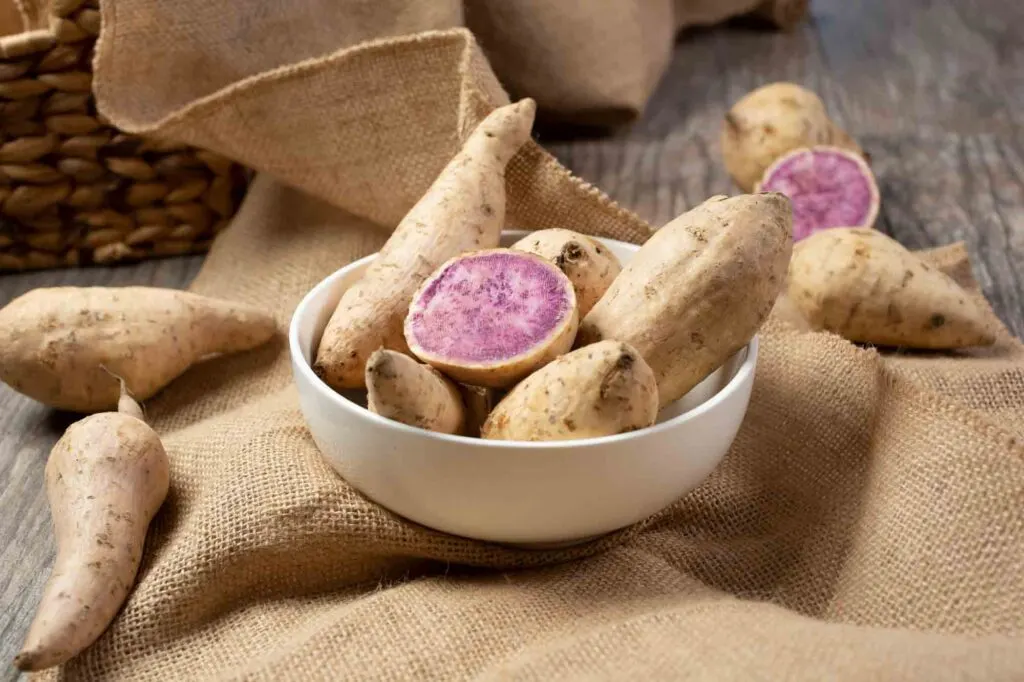
Okinawan sweet potatoes are a staple food in Okinawa, an island in Japan where people live the healthiest and longest.
These variants of sweet potatoes contain a lot of anthocyanin content and can help improve brain health, increase immunity, and reduce inflammation. They are also rich in vitamins A, B, and Potassium.
According to a study, purple sweet potatoes have anti-inflammatory properties and can protect against certain types of cancer, including colon cancer.
These purple potatoes taste similar to orange and white potatoes, but they have a lower glycemic rate. For this reason, they are a bit less sweet and great for diabetes and pre-diabetes.
More Purple Foods
Here are a few more purple-colored foods for your plate:
- Purple cabbage
- Purple artichoke
- Purple asparagus
- Purple Brussel sprouts
- Purple bell pepper
Did you enjoy reading about purple foods? Then share this article on your social media!
